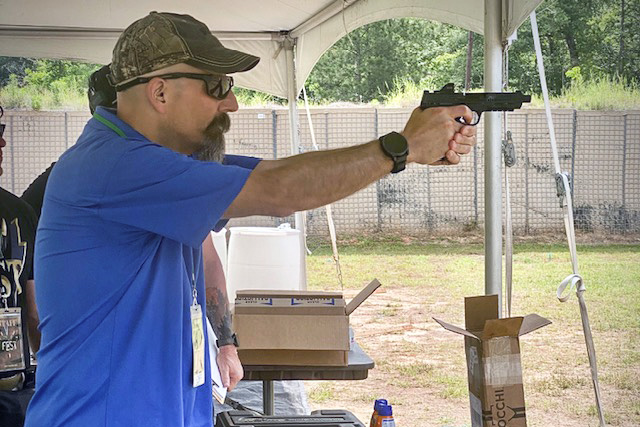
For the record, I own, shoot, and enjoy guns that are chambered for the 5.7×28 round. It’s ultra-fast and uber-fun. But is it another one of those “solutions in search of a problem” like many of the other allegedly hot calibers that have come and gone over the years?
I readily accepted an invitation to the 5.7 Fest, a media/industry deal put together by Ryan Gresham and the team at GunTalk Media. There, I was promised opportunities to try different guns, ammunition, and accessories. That sounded like a good time and it certainly was.
But when I arrived, I made no bones about my singular goal for the trip: to learn if the 5.7×28 round has demonstrable practical applications. I didn’t care if it proved to be the best as a farm/ranch gun for varmint control, a pistol for personal protection or a carbine for home defense, I just wanted to know if the round was useful.
I already knew it had the capability to vaporize varmints, kill coyotes and generally convert ground hogs into fertilizer. But from my experience, a farm/ranch rifle should also be capable of killing bigger threats, from coyotes to the big, angry farm animal that suddenly decides you are no longer necessary and decides to solve his problem.
Two days later, I have plenty of knowledge about the round, the various guns that chamber it, and the various flavors of ammo they’ll all run. But I can’t give a definitive answer as to a single best application for the gun that works for everyone outside plinking or varmint control.
Would I use it for personal defense? Absolutely. And in the hands of more competent shooters, the gun could be used for hunting larger game. In the hands of more competent shooters the small round does a lot of things very well.
But the cartridge is more complicated than most. It’s a small and fast round. And small things moving at really high speeds are subject to bigger influences from things that effect larger calibers less.
If you want to turn 5.7×28 from a full-sized, five-inch gun into a reduced capacity shorter barreled version designed to be more easily concealed, it’s not as simple as lopping off a couple of inches of barrel and reducing the round count to shorten the grip and magazine.
The 5.7×28 bullet is an itty bitty projectile riding a great big pile of pressure. Simply explained, says Ruger’s Tabor Smart, it’s difficult to stabilize a projectile when the barrel length gets under about five inches. That’s why the pistols from Ruger, Smith & Wesson, and Tisas that we shot were all thin and light, but otherwise full-sized.
That’s a benefit and a challenge. The benefit? The smallest of the magazines we used in the 5.7 Fest held 20 rounds. That’s a lot of ammo at the ready. The challenge? Making a smaller, more compact model.
Barrel length’s never been an issue in carbine and PDW-length guns. After all, the 5.7×28 round was originally created for just that application.
There are more than a couple of issues involved in the creation of a fast and light round. To function effectively, Smart explained, the action has to move far enough to cycle the gun and remove the shell casing. The 5.7×28 cartridge has a small projectile with a long case. To cycle effectively, the gun has to move a bolt of sufficient weight and extraction strength to pull the spent round from the chamber.
When you hear short and long actions in rifles, that’s what they’re referring to…the room needed to cycle the gun.
To get the most out of the gun performance-wise, you also need a barrel that’s long enough to stabilize the round. Testing from the manufacturers and ammo makers say the minimum based on today’s ammunition and technology is five inches. That, says Smart, doesn’t mean there won’t be smaller, more concealable 5.7×28 pistols, only that it won’t happen until the technology allows it.
I didn’t know that 5.7×28 is a coated round. That coating, Smart told me, is really the “secret sauce” when it comes to getting ammunition to the point it functions reliably. Introduce suppression and all those balances go out of kilter again. For a small round, there are enough variabilities in bullet weight, configuration, and round coatings — plus the internal geometry of the gun itself — to make a mathematician’s head swim.
The situation’s the same when it comes to sights and optics. “The manufacturers today have all discovered,” Smart tells me, “that when it comes to optics on these pistols, you’re looking at a maximum weight of 2 to 2½ ounces.” Otherwise, he explains, “you’re messing with the operational aspects of the gun.”
There’s no doubt the round is accurate up to “about 100 yards.” Remember, the 5.7×28 was designed as a round for compact personal defense weapons, not long distance shooting or hunting. At 50 yards, I easily shot a 10-shot group of an inch and a half with five in the x-ring. There were plenty of smaller groups put up at 5.7 Fest. The writers in attendance are all very solid shooters.

Staying inside the 100 yard distances, there’s no doubt the round is more than capable of inflicting pretty serious damage in a defensive situation. In fact, there was a recent incident in Louisville, Kentucky where a 5.7×28 pistol was used to stop an assault. The attacker was put down by a pair of the diminutive rounds.
We spent a considerable amount of time shooting pistols from Tisas, S&W and Ruger into ballistic gel, and the results were revealing. The 5.7×28 has always been billed as a round that would be suitable for law enforcement due to its lack of over-penetration.
No police officer or department wants that and the 5.7×28 demonstrated the ability to create a serious wound cavity and still remain inside a 14-inch gel block. A 9mm round passed through the first block and traveled several inches into a second.


That’s a point for the round. And no officer ever complained about having more ammunition on hand. One former officer told me he also believed the 5.7×28 would produce more accurate hits in shooting situations when compared to 9mm.
So is the 5.7×28 a round with growth in its future? Probably. After languishing for several years, gun and ammunition makers are putting time, resources, and research into the round.
Lots more coming from 5.7 Fest in the future including accessories, targets and optics.
As always, we’ll keep you posted.


Every round has it’s usefulness. Whether that be target shooting, self defense or war against tyranny.
There is so much I like about that round (excepting the price), many of them mentioned above.
However –
That round is hideously *Loud*, and will do my mild case of tinnitus no good at all…